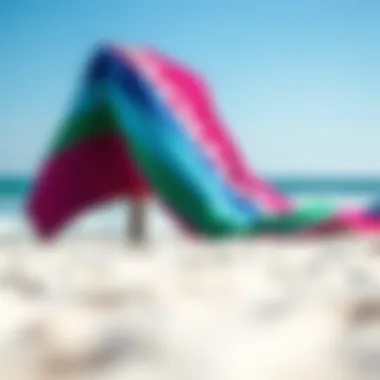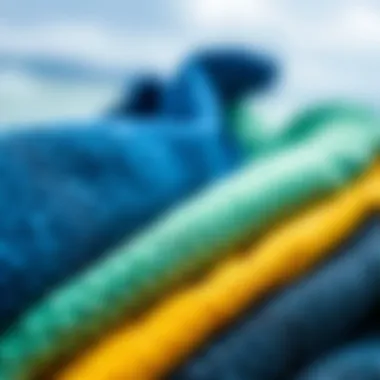The Essential Guide to Surf Changing Towels: Functionality and Benefits


Intro
Surfing and kiteboarding both embrace the exhilaration of riding the waves, yet they come with their unique challenges. Among these, the need for practicality and comfort cannot be overstated, especially when it comes to changing out of wet gear. Enter the surf changing towel. In the bustling kiteboarding scene, this seemingly simple accessory is far more than just a convenient piece of fabric—it becomes a crucial part of the experience.
Not all towels are made equal, and those designed for surfers and kiteboarders are purpose-built to meet specific needs. They help keep the chill at bay, facilitate quick changing, and provide a bit of much-needed privacy, particularly in crowded beaches or parks. In this guide, we'll delve into everything from material choices to care instructions, ensuring you’re well-equipped to select the best surf changing towel for your next adventure in the water.
Moreover, we will explore how these towels function not just as personal items but as integral components of the kiteboarding lifestyle, enhancing each session on the water. Whether you’re just starting or have years of experience under your belt, understanding these towels’ functionality and benefits can dramatically impact your kiteboarding experience. Let's get into the nitty-gritty of equipment selection and essential tips for maintaining gear.
Equipment Selection
When it comes to kiteboarding, equipment selection can be as critical as understanding the sport itself. A wrong choice can lead to discomfort or even hinder performance. The right surf changing towel fits snugly into this puzzle, serving a unique function alongside your kite and board.
Choosing the Right Towel
Choosing the right surf changing towel doesn't have to be a headache. First off, consider the size. A larger towel offers more coverage for changing, while a smaller option might be more portable. Portability matters, especially for those who travel far from home.
When it comes to materials, options include microfiber, cotton, and even bamboo blends. Microfiber towels dry quicker and are lightweight, making them an excellent choice for traveling kiteboarders. In contrast, cotton towels tend to offer more warmth but may take a bit longer to dry.
“The right towel can change your experience in ways you may not even imagine.”
With colors and designs, it’s about personal preference. Stand out with vibrant prints or keep it classic with solid colors; the choice is yours. Each aspect contributes to a more enjoyable session on the water.
Boards & Accessories Overview
While surf changing towels are an essential accessory, they are part of a larger ecosystem of gear that every kiteboarder should consider. Take your boards, for instance. Different boards cater to varying skill levels and styles of riding. It’s also important to think about the accessories you pair with your kite and board.
- Harness: A good harness ensures that your connection to the kite is secure, allowing for more freedom of movement.
- Bar and Lines: These elements give you control over your kite and should fit your skill level.
- Safety Gear: Don't overlook impact vests or helmets. They are vital for safety during your sessions.
By ensuring that all components of your setup, including changing towels, work harmoniously together, you can optimize your experience on the water while maintaining comfort and convenience.
Understanding Surf Changing Towels
When it comes to kiteboarding, equipment and accessories can make a significant difference in overall experience and performance. Surf changing towels are one such accessory that seamlessly combine functionality with practicality. As any seasoned kiteboarder will tell you, the windy beaches and unpredictable weather often demand gear that not only serves a distinct purpose but also enhances comfort. By taking a closer look at surf changing towels, we can appreciate how they address multiple needs of kiteboarders—from changing in public spaces to providing essential sun protection.
What Is a Surf Changing Towel?
A surf changing towel is generally larger than your ordinary beach towel and specifically designed for the needs of watersports enthusiasts. It typically features a poncho-style design or comes equipped with a hood, allowing for easy changing without exposing oneself to the elements—or prying eyes. The sizes can vary, but most offer generous dimensions to provide ample coverage, whether you're getting into your wetsuit or simply drying off after a session on the waves.
While some towels are designed with quick-dry fabric, others prioritize extra softness for post-surf comfort. This versatility is one of the main reasons they are favored in the kiteboarding community.
Purpose and Importance
Understanding the purpose of surf changing towels goes beyond just their physical attributes. These towels serve various practical functions that can greatly impact the experience of kiteboarders:
- Privacy: Changing in public areas is often unavoidable; a dedicated changing towel offers a sanctuary of privacy.
- Comfort: The soft materials usually used enhance comfort during and after changing, preventing irritation from sand or wet skin.
- Protection: Not only do they shield against the wind and sun, but they also help keep the sand off your clothes and gear.


Furthermore, good surf changing towels may also come with pockets, which adds an element of convenience for storing small items like keys or even snacks. This multi-functionality emphasizes their importance in every kiteboarder's kit.
Materials Used in Surf Changing Towels
The choice of materials in surf changing towels is not just a mundane detail but a crucial factor that affects functionality, durability, and user experience. Surf changing towels serve as both a practical tool for changing clothes in public without flashing anyone and a means to maintain comfort after surfing. Considering the vast range of materials available on the market can be daunting; however, understanding their properties helps in selecting the best towel for your needs.
Cotton Towels
Cotton is perhaps the most traditional fabric used in towels. One of its standout characteristics is its absorbency. Cotton towels can soak up a significant amount of water, which is particularly useful after a surf session. They offer a plush feel against the skin, enhancing comfort when you’re wet and cold.
However, there are some caveats. Cotton towels tend to be bulkier and heavier than their counterparts. For someone traveling to the beach, carrying a heavy load is not ideal. Another downside is drying time. After a session at the beach, a cotton towel can take a long while to dry, making it less convenient if you plan on multiple runs throughout the day.
Microfiber Towels
Microfiber towels have become a favorite among surfers and those engaged in outdoor activities. They are made from a blend of polyester and polyamide, making them not only exceptionally lightweight but also fast-drying. One of the primary advantages of microfiber towels is their ability to absorb up to seven times their weight in water, making them highly effective for drying off after surfing.
Also, they fold down to a compact size, fitting easily into any bag. This portability makes them a go-to option for travelers and active individuals. On the flip side, microfiber can feel less cozy against the skin than cotton, often leading some users to miss that fluffy texture they find in traditional towels. These towels may also require special washing methods to maintain their integrity over time.
A well-chosen microfiber towel, though, can be a game-changer when you need efficiency and space-saving features in your gear.
Eco-Friendly Options
With a growing awareness around environmental issues, many brands now offer eco-friendly surf changing towels. These towels are typically made from sustainable materials like organic cotton, recycled polyester, or bamboo fibers. One significant benefit is that they contribute to reducing your environmental footprint, an important consideration in today’s world.
Using eco-friendly options often means those towels are free from harmful chemicals, making them a better choice for sensitive skin.
However, it’s essential to note that eco-friendly does not always mean performance is compromised. Many high-quality eco-friendly towels have excellent absorbency and quick-drying properties, matching or even surpassing traditional options.
Choosing an eco-friendly towel is a conscious step towards sustainability that can also offer the performance surfers need.
In summary, while selecting the right towel, consider not only the material but how it aligns with your lifestyle and needs. Balancing functionality with a commitment to the environment can guide you in making a well-informed choice.
Choosing the Right Surf Changing Towel
Selecting the proper surf changing towel may seem trivial, yet it plays a crucial role in enhancing your overall kiteboarding experience. A well-chosen towel not only provides comfort but also significantly improves practicality when out on the water. So, what should one consider when choosing the right surf changing towel? Let's take a look.
Size Considerations
Size is not just a matter of preference; it's a fundamental aspect that directly impacts functionality. Ideally, a surf changing towel should be large enough to provide ample coverage while allowing for easy maneuverability. A common recommendation is to aim for towels that measure at least 80 inches in length. This provides enough material to wrap around your body, ensuring you can change comfortably without worrying about exposure.
In some cases, oversize towels can also double as a compact sunshade, especially on those scorching summer days. However, be cautious; larger towels may be cumbersome in windy conditions or when packing your gear for travel.
Quote:
Practical Uses of Surf Changing Towels
Surf changing towels are not merely an accessory; they serve multiple practical purposes in the lives of kiteboarders and surfers alike. As anyone accustomed to water sports knows, transitions from a thrilling ride back to dry land can be a challenge. These specialized towels enhance the experience by offering comfort, privacy, and practicality.


Changing in Public Spaces
One of the prime uses of surf changing towels is facilitating changes in public spaces. Picture this: you’ve just conquered waves, feeling exhilarated but in need of a dry change before heading back. The beach may be bustling, making privacy a luxury. This is where surf changing towels come into play. With a towel that offers both width and length, you can easily wrap yourself for a discreet change.
These towels often come with a hood or sleeves, which can offer extra cover. This feature means not only do you have a suitable covering, but you also can keep warm while you switch out of wet suits into regular clothes. Plus, the quick-drying materials minimize discomfort from lingering cold water on skin.
Post-Surf Comfort
After a long session in the surf, nothing beats the comfort of wrapping yourself in a dry towel. Surf changing towels often utilize soft materials that feel great against the skin. The unique designs can also retain body heat, which is essential when stepping out of chilly waters.
Moreover, they’re ideal for wiping down or drying off after sessions in the water. Rather than toting multiple towels, a compact surf changing towel can often do the job effectively. Lightweight design enhances portability, so tossing it into a gear bag doesn’t weigh you down.
Key Benefits:
- Warmth: Keeps the body warm immediately post-surfing.
- Comfort: Soft fabrics provide a cozy feeling against the skin.
- Consolidation: Functions as both a towel and changing garment.
Sun Protection
It’s not just the cold waters that pose a challenge; sun exposure is a real concern too. Surf changing towels often come with fully covered designs which can act as a shield against harmful UV rays. Wearing one can offer protection to your skin, especially when you might not have time to put on sunscreen before hitting the beach.
Even after drying off, they can serve as a lightweight cover-up when lounging on the beach or actively rehydrating. This versatility ensures you stay covered while still allowing you to enjoy the sun. Plus, investing in eco-friendly options that offer this protection can be a win-win for both your skin and the environment.
"A good surf changing towel should be a multi-purpose tool that adds comfort, style, and a layer of protection beyond mere utility."
How to Care for Your Surf Changing Towel
Caring for surf changing towels is an aspect that often gets overlooked until the first signs of wear begin to show. A well-kept towel not only serves its purpose but also aids in maintaining the overall experience of kiteboarding. Understandably, after a long session at sea, the last thing on your mind might be how to properly care for your towel. However, a little attention goes a long way. Proper maintenance ensures that your towel remains absorbent, soft, and odour-free, significantly enhancing your post-surf routine.
Washing Instructions
When it comes to washing your surf changing towel, adhering to specific guidelines can prolong its life. Most towels made from cotton or microfiber can be tossed in the washing machine, but a few precautions are wise to keep in mind:
- Use Cold Water: Hot water can damage the fibers, especially in microfiber towels, which are sensitive to heat. Stick to cold cycles for washing.
- Detergent Matters: Opt for a mild detergent. Strong chemicals might strip away the natural softness of cotton or damage the inherent qualities of microfiber.
- Avoid Fabric Softeners: While tempting, fabric softeners can leave a residue that decreases absorbency. They interfere with the towel’s ability to wick moisture.
By following these washing instructions, you not only maintain the integrity of the towel but also ensure it continues to perform effectively time and time again.
Drying Techniques
After the wash comes the drying part, which is just as crucial in the care process. Improper drying methods can lead to nasty surprises, like mildew or a rough texture. Here are solid drying practices:
- Air Drying: Whenever possible, hang your towel to air dry. This method is gentler on the fabric and prevents shrinkage that can occur in the dryer.
- Low Heat Settings: If you use a dryer, stick to low heat settings. High temperatures can cause fibers to break down, ultimately shortening the towel’s lifespan.
- Shake It Out: Before drying, give it a good shake. This plumps up the fibers, enhancing softness and loftiness.
Even though these drying techniques take a bit more time, they preserve the quality of your towel, making it a reliable companion in future kiteboarding adventures.
Storage Tips


How you store your surf changing towel can make a significant difference. Neglecting storage can lead to unpleasant smells and can even damage the materials. Here are practical storage ideas:
- Clean Before Storing: Always store your towel clean and dry. Storing damp towels can lead to mildew or musty odours that are hard to remove.
- Store in a Cool, Dry Place: Avoid damp or humid areas that promote mould growth. Instead, opt for a climate-controlled environment.
- Avoid Folding It for Longevity: If you can, roll the towel instead of folding it. Rolling prevents creases that can develop into wear points over time.
By ensuring that you follow these storage tips, you contribute to a longer life for your surf changing towel, making it a steadfast ally during your time on the water.
"While the waves may call you out to the sea, caring for your gear makes sure you keep coming back for more."
Ultimately, a few simple steps in washing, drying, and storing make an enormous impact. Not only will your surf changing towel be ready for use, but it will also play its part in enhancing your kiteboarding experience.
Environmental Impact of Surf Changing Towels
In today's world, where environmental concerns are pressing, understanding the ecological footprint of gear we utilize is crucial. Surf changing towels, while designed for convenience and comfort, also impact the environment in various ways. By digging into their material sustainability and recycling options, we can better appreciate their role not just as a practical item, but also as part of a larger movement towards eco-consciousness in activities like kiteboarding.
Sustainability of Materials
When considering surf changing towels, it’s vital to think about the materials they are made from. Many of these towels are produced using natural fibers, such as cotton. Cotton, being a renewable resource, can be a better choice compared to synthetic alternatives. However, it’s not just about being renewable; the farming processes should also be sustainable. The cotton industry has faced criticism for heavy pesticide use and water consumption. Opting for organic cotton towels can make a difference here, as they reduce chemical use and promote biodiversity.
Microfiber towels have grown in popularity due to their lightweight and quick-dry properties. Yet, their environmental impact deserves scrutiny too. Made from polyester and polyamide, these fabrics are derived from petroleum, a non-renewable resource. The production of synthetic materials often involves emissions and pollution that are harmful to our planet. However, some brands are exploring methods to recycle plastic waste into microfiber, thus minimizing their ecological footprint.
"Choosing surf changing towels made from eco-friendly materials isn’t just a trend; it’s a necessary step towards responsibility in our water sports community."
Recycling Options
Once the surf changing towel has seen its day, what happens then? Recycling plays a pivotal role in reducing waste. Many people might toss their old towels without a thought, but knowing that some options exist can encourage more eco-friendly choices. Some manufacturers have programs for returning or recycling old towels. Additionally, those who are keen can upcycle towels into other usable items like cleaning rags or even dog beds.
Furthermore, awareness is growing about the implications of microfibers released during washing. This calls for more developments in fabric technology and washing practices to mitigate microfiber pollution in oceans. Some companies are now designing Guards, simple devices to be placed in washing machines to catch microfibers before they reach waterways.
Ultimately, as kiteboarders and water sports enthusiasts, we hold the power to make informed decisions about our equipment. By advocating for sustainable materials and recycling initiatives, we not only enhance our own experiences but also contribute positively to the environment. When selecting surf changing towels, consider how they are made and what you can do to give them a responsible end-of-life phase.
Finale: The Value of Surf Changing Towels in Kiteboarding
The role of surf changing towels in kiteboarding extends beyond their basic functionality. These towels cater to the unique needs of kiteboarders, enhancing their experience in various ways. Key benefits come to light when one considers how often these athletes find themselves quickly transitioning between water and land. Not only do these towels provide privacy while changing out of wet gear, but they also offer a much-needed layer of comfort post-session.
Firstly, integrating surf changing towels into your kiteboarding kit is crucial for anyone that hits the waves regularly. Kiteboarding often involves exposure to sun, wind, and water, creating an environment where quick changes are sometimes inevitable. The changing towel serves as a portable dressing room, allowing individuals to maintain their dignity while addressing the practicalities of wet clothing. This can significantly boost the overall enjoyment of the session, relieving the stress of changing in public places or cramped vehicles.
Secondly, the variety of materials and designs available ensure that there’s a perfect towel for every kiteboarder, whether they prioritize moisture-wicking abilities, size, or sustainable options made from eco-friendly materials. A towel that’s quick to dry and easily portable seamlessly fits into a travel kit or van, significantly impacting how a kiteboarder navigates his or her day on the beach.
Integrating Towels into Your Kiteboarding Kit
When looking to incorporate surf changing towels into your kiteboarding gear, consider these factors:
- Size and Portability: Look for towels that conveniently fold into a small package but expand large enough to provide adequate coverage when changing.
- Material: Consider options like microfiber or lightweight cotton that dry quickly and resist sand. Some brands offer towels with water-repellent features, making them ideal for beach environments.
- Design and functionality: Towels with pockets can serve dual purposes, carrying small essentials while you change.
Before you hit the water, check your setup. Having a designated space in your board bag for your towel can make it easy to access after your ride.
Final Thoughts on Selection and Use
Choosing the right surf changing towel isn’t just about materials; it’s about matching the towel’s features to your specific needs as a kiteboarder. Some may prefer vibrant designs, while others might value less flashy, more functional options.
- Cleanliness: Maintain your towel to ensure longevity. Wash regularly to keep it fresh and free from salt and sand.
- Weight: A feather-light towel can mean the difference between ease of movement on the beach and being burdened by excess gear.
- Usage Beyond Kiteboarding: These towels can be multi-purpose. They can double as a beach blanket or a quick sun shield.
The integration of surf changing towels into your gear bag enhances not only the practicality of changing out of wet suits but improves the entire surf experience. No matter your level of expertise, these towels prove to be an essential accessory in the kiteboarding community.







